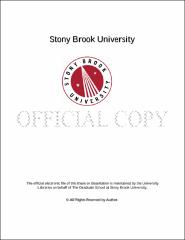| dcterms.abstract | Optimal Mass Transport theory has deep roots in pure mathematics, combining complex analysis, Riemannian geometry and measure theory. Monge first raised the classical Optimal Mass Transport Problem that concerns determining the optimal way, with minimal transportation cost, to move a pile of soil from one place to another. Kantorovich has proven the existence and uniqueness of the optimal transport plan based on linear program. Monge-Kantorovich optimization has been used in numerous fields from physics, econometrics to computer science including computer vision, medical imaging and statistics. However, it has one fundamental disadvantage that the complexity is $O(k^2)$, which is unacceptable to computer vision and visualization applications since a high resolution 3D surface normally includes up to hundreds of thousands of vertices. In this dissertation, we introduce a practical optimal mass transport map based on Brenier's approach, which reduces the complexity from $O(k^2)$ to $O(k)$ and improves the efficiency and applicability. And we use our approach to address three practical applications of computer vision, medical imaging, and visualization. Firstly, in computer vision, surface based 3D shape analysis is popular and critical. We proposed to use optimal mass transport map for shape analysis, focusing on two important shape analysis applications including surface registration and 3D shape classification. For surface registration problem, one commonly used approach is to use conformal map to convert the shapes into some canonical space. Although conformal mappings have small angle distortions, they may introduce large area distortions which are likely to cause numerical instability thus resulting failures of shape analysis. This work proposed to compose the conformal map with the optimal mass transport map to get the unique area-preserving map, which is intrinsic to the Riemannian metric, unique, and diffeomorphic. For 3D shape classification study, we presented a novel Riemannian framework, \emph{Conformal Wasserstein Shape Space}, by combing conformal geometry and Riemannian optimal mass transportation theory. In our work, all metric surfaces with the spherical topology are mapped to the unit sphere by a conformal mapping, which pushes the area element on the surface to a probability measure on the sphere. The Riemannian optimal mass transportation provides a map from the shape space of all topological spheres with metrics to the Wasserstein space of the disk and the pullback Wasserstein metric equips the shape space with a Riemannian metric. We validate our work by a real 3D classification problem of categorizing human brains with different intelligence quotient. Secondly, in medical imaging, brain mapping transforms the brain cortical surface to canonical planar domains, which plays a fundamental role in morphological study. Most existing brain mapping methods are based on angle preserving maps, which may introduce large area distortions. Thus we proposed an area preserving brain mapping method based on Monge-Brenier theory. The brain mapping is intrinsic to the Riemannian metric, unique, and diffeomorphic. The computation is equivalent to convex energy minimization and power Voronoi diagram construction. Comparing to the existing approaches based on Monge-Kantorovich theory, the proposed one greatly reduces the complexity (from $k^2$ unknowns to $k$ ), and improves the simplicity and efficiency. Experimental results on caudate nucleus surface mapping and cortical surface mapping demonstrate the efficacy and efficiency of the proposed method. Conventional methods for caudate nucleus surface mapping may suffer from numerical instability; in contrast, current method produces diffeomorphic mappings stably. In the study of cortical surface classification for recognition of Alzheimer's Disease, the proposed method outperforms some other morphometry features. Finally, in the visualization field, with the fast generation of large and complicated data nowadays, it is highly desirable to develop new frameworks aiming at generating a visualization of the entire data needed for navigation, detection, exploration and a global understanding of selected objects or regions of interest (ROIs). Angle-preservation (conformal) mapping/surface flattening preserves local shapes, and thus has been broadly used in many feature oriented applications in visualization and medical imaging. However, conformal method usually substantially distorts area, which fails to display accurate size of area, including height, width, thickness or diameter of ROIs. Unfortunately, these distorted area parameters are extremely important in many medical image recognition and auto diagnosis applications, such as brain fold detection or colon polyps detection and diagnosis. Therefore, we proposed to use our optimal mass transport map to address visualization applications that are beyond the scope of conformal mapping. | |

